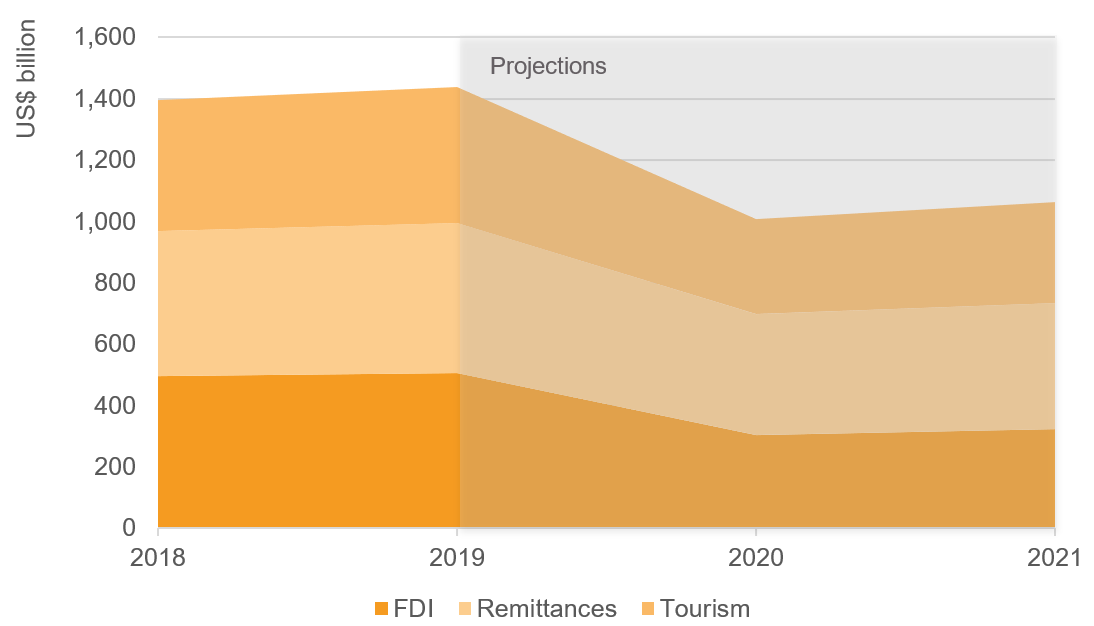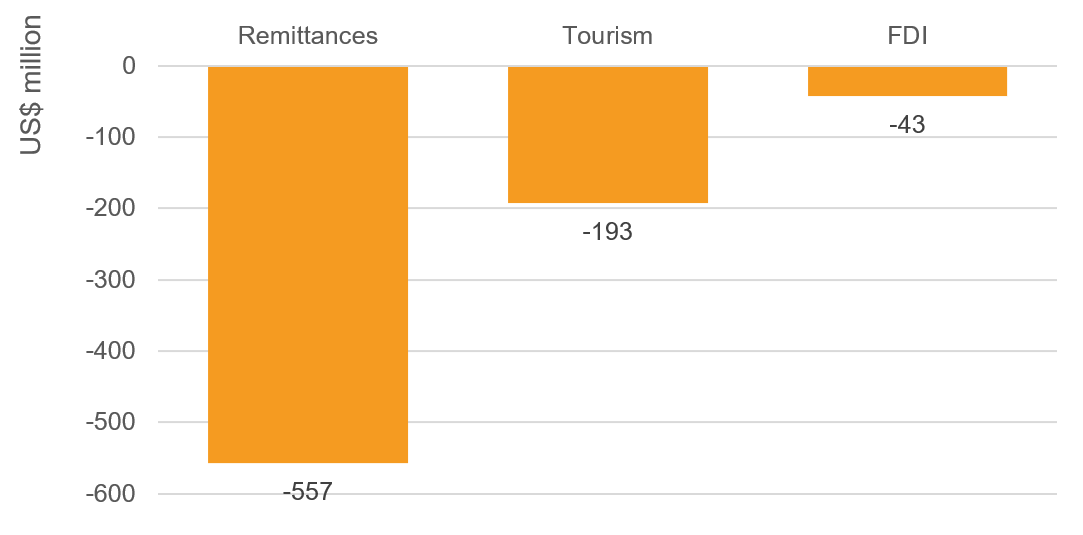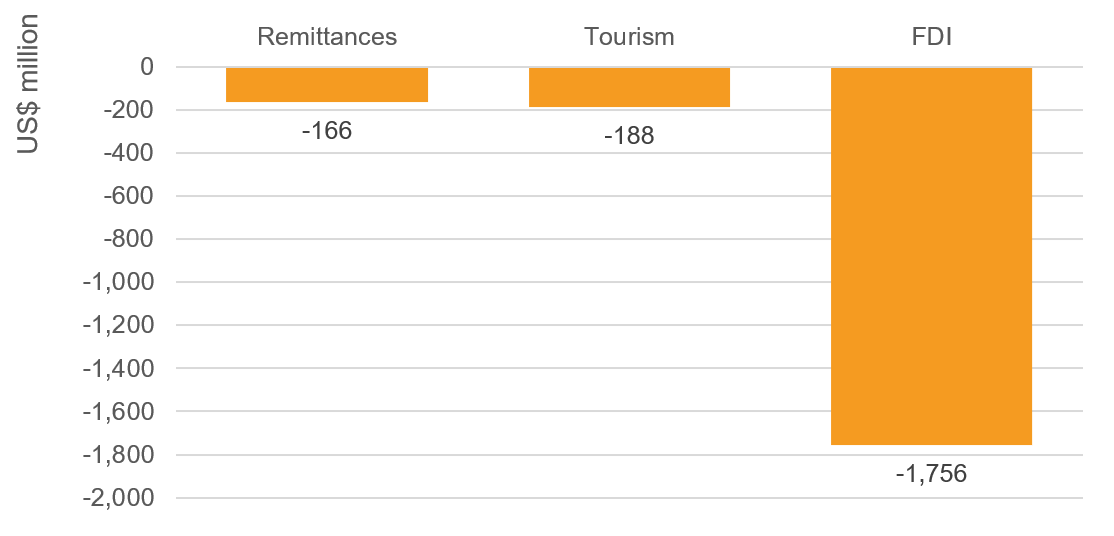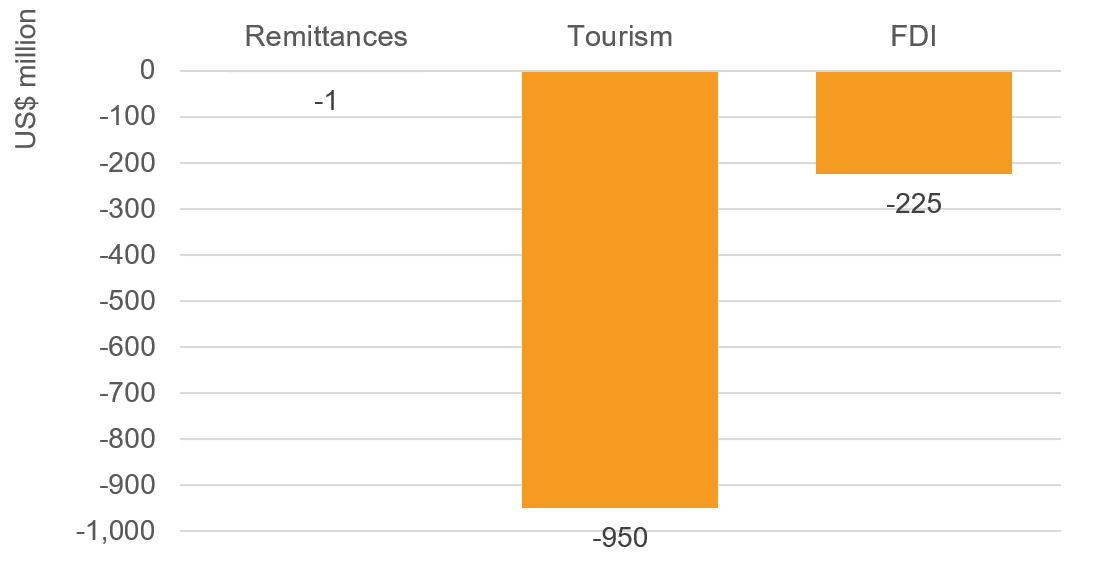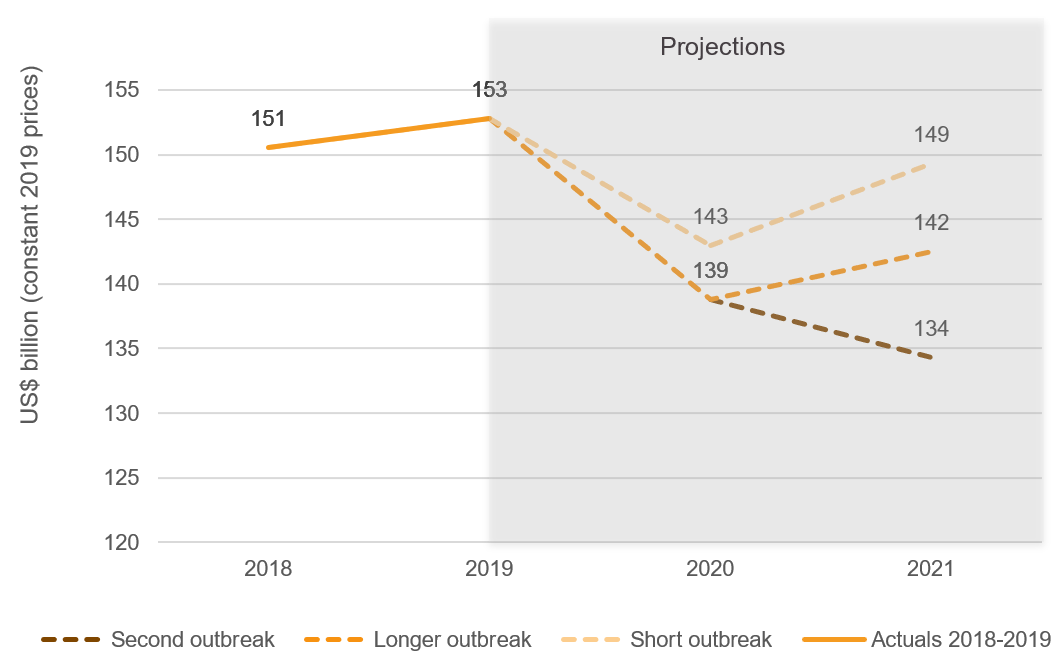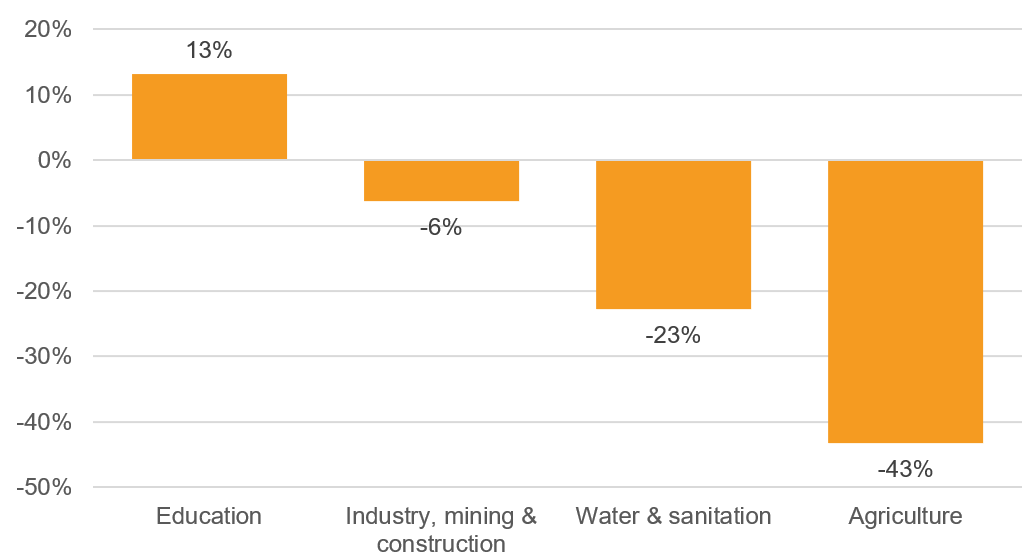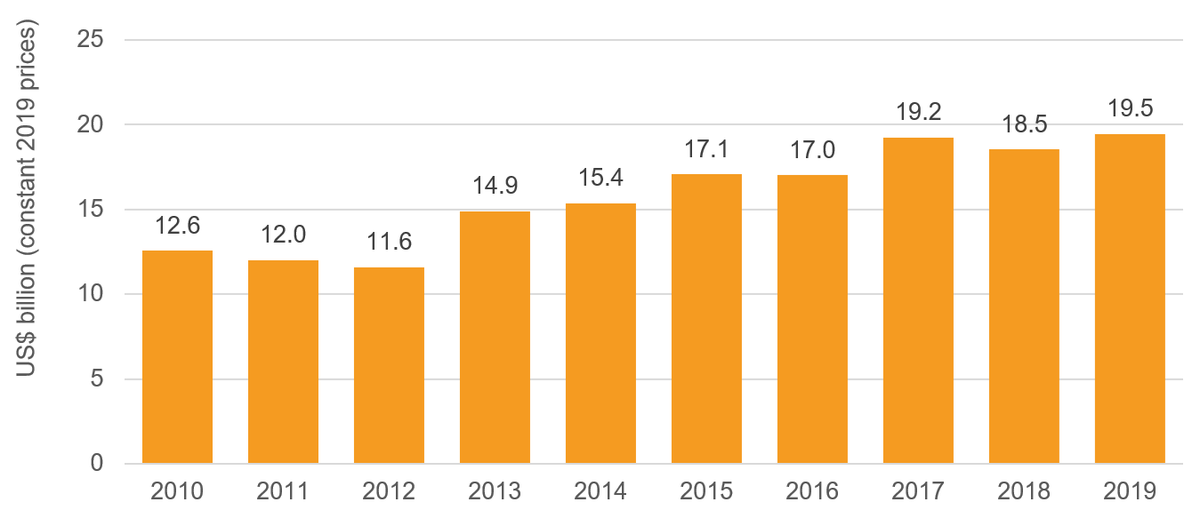Covid-19 and financing projections for developing countries
This briefing unpacks projections on the likely impact of Covid-19 on financing for developing countries. How can this inform the response to ensure no one is left behind?
DownloadsIntroduction
The Covid-19 pandemic is having a significant impact on people, countries and economies across the world. Global poverty is expected to rise by tens of millions of people, at least, at the same time as the global economy shrinks. Crucially the pandemic will impact all forms of finance and the level of resources available in developing countries – domestic and international, public and private.
While so much is uncertain in such unprecedented times, we can use current economic projections and reforecasts in light of Covid-19 to estimate what the potential impact of the pandemic will be on financing for developing countries, at least for the next two years. This briefing unpacks those projections to evidence what the future is likely to hold and therefore where we need to focus our efforts to ensure the poorest people and countries are supported to manage the ongoing effects of the crisis.
Finally it looks at what ‘building back better’ means when it comes to improving the financing system for sustainable development, and where the main areas for change need to be if we are indeed to seize this moment to make more fundamental changes that could have a transformative effect in the longer term.
Summary
- Global poverty is projected to rise. Even though the poorest countries are not predicted to fall into recession, a global downturn means falling investment, commodity prices, remittances, and income from tourism, which will all have a negative impact.
- Domestic public resources are critical to achieving the SDGs but are projected to fall by US$1.7 trillion in developing countries over the next two years, even in an optimistic scenario. If there is a longer outbreak, and the effects of the pandemic continue to be felt into 2021, a fall of US$3 trillion in public domestic resources is estimated.
- Foreign direct investment (FDI), remittances and tourism receipts are projected to fall substantially yet are crucial for the least developed countries. Estimates indicate FDI could fall by 40%, tourism by 30% and remittances by 15%.
- Country-level analysis shows significant variations in how developing countries will be impacted. For example, Haiti’s reliance on remittances means projected reductions in this would equate to a significant 6% reduction in gross domestic product (GDP). In the Republic of Congo, the projected fall in FDI would mean an even greater 15% reduction in GDP.
- The economic recession is likely to drive significant reductions in official development assistance (ODA). Estimates vary depending on different scenarios playing out in terms of the pandemic and economic recovery. Depending on the scenario, it is possible that ODA could fall in both 2020 and 2021, and that it could fall from the 2019 levels of US$153 billion to US$128 billion by 2021.
- Lessons from other crises such as Ebola indicate there is a real risk that funding will be diverted away from critical sectors such as agriculture (which lost almost half its funding during the first two years of the Ebola crisis), and water and sanitation (which lost almost a quarter of its funding over the same period).
- Debt owed by developing countries will impede their response and recovery. Even before the Covid-19 pandemic, there were concerns that growth in ODA lending over the last decade was contributing to a new debt crisis. High levels of debt have implications for developing countries and their ability to respond to the pandemic – 64 developing countries spent more on servicing debt than on their health sector in 2019.
- These projections paint a worrying picture, but there is some hope with an emerging narrative about how we can ‘build back better’ for the medium–longer term. The priorities for reform need to be: better cooperation that is globally connected but locally driven; institutional transformation that devolves currently concentrated global power; and an approach to financing that is more risk-aware, effective and better targeted. Covid-19 is not the only global crisis we will face, and reform is desperately needed to improve our response at all levels.
Global poverty
The International Monetary Fund (IMF) is projecting that Covid-19 will result in the biggest recession since the Great Depression, affecting all countries. However, the economic picture is complicated: advanced economies (already experiencing sluggish growth) are projected to suffer the greatest losses, while some of the poorest countries with relatively high growth rates may not see an actual recession in 2020 or 2021. The IMF actually estimates that low-income developing country economies will grow by a very small 0.4% as a group. These are just projections, but one thing that is apparent from previous crises is that a global economic downturn will nevertheless have an impact on the poorest countries and people, with falling investment, commodity prices, remittances and income from tourism all having a negative impact.
Experts agree that an increase in the numbers living in extreme poverty is likely for the first time since 1998, but estimates vary significantly – the World Bank’s latest forecast suggests that between 40 and 60 million people will fall back into poverty, while a study for the UN University suggests the figure is anywhere between 20 million and half a billion people (see Figure 1). Much will depend on action taken now to manage the impact.
Figure 1: Projected increases in extreme poverty levels

Projected increases in extreme poverty levels
Source: Estimates taken from World Bank PovcalNet and Sumner A., Hoy C. and Ortiz-Juarez E., ‘Estimates of the impact of COVID-19 on global poverty’, UNU-Wider, Working Paper 43/2020, https://doi.org/10.35188/UNU-WIDER
Domestic public resources
Domestic resources are fundamental to not only delivering the Sustainable Development Goals (SDGs) but also mitigating the effects of the current crisis. Even if the Covid-19 pandemic does not push some of the poorest countries into recession, it will still have a huge effect on their fiscal position.
Figure 2, based on IMF data, looks at domestic revenue projections prior to the crisis and the impact of a shorter-term economic downturn caused by the pandemic.
Figure 2: Projected developing country government revenue, 2019–2021
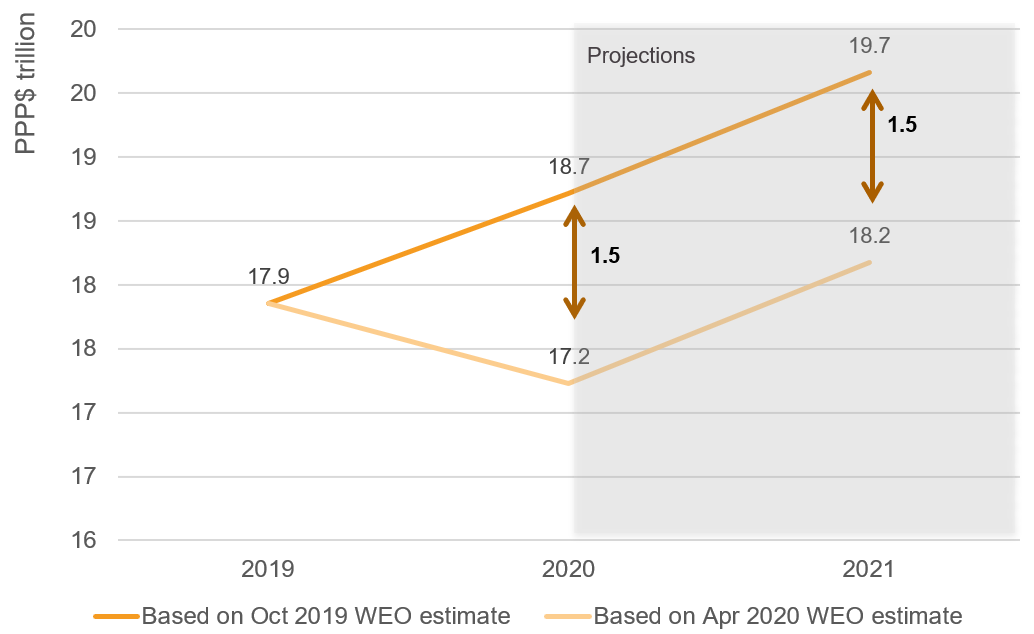
Projected developing country government revenue, 2019–2021
Source: Development Initiatives, based on the IMF’s World Economic Outlook Databases from October 2019 and April 2020.
Notes: WEO = World Economic Outlook; PPP = purchasing power parity.
Key issues in Figure 2
- In total, developing countries had almost US$18 trillion in domestic revenue in 2019 (purchasing power parity dollars, PPP$).
- If this revenue rose in line with gross domestic product (GDP) then, using the growth estimates published by the IMF in October 2019, this would have risen to US$19.7 trillion (PPP$) by 2021.
- Under the new forecasts, government revenue could be US$1.5 trillion lower in 2020 and another US$1.5 trillion lower in 2021 (PPP$) – a total loss of US$3 trillion.
- Most of the losses will be sustained by middle-income countries. However, under these projections, 2020 revenues for least developed countries (LDCs) will be 4.4% lower than under pre-Covid-19 estimates. This is compared to a reduction of 5.5% for non-LDCs.
- This projection is based on a less optimistic scenario than the IMF baseline (a short, if sharp, outbreak and recession), which assumes a longer outbreak where the pandemic and measures to manage it, such as lockdown, continue into the second half of 2020 with economic and other recovery taking hold later in 2020 or into 2021.
Foreign direct investment, remittances and tourism receipts
While it is hard to reliably predict what will happen to international finance flows to the poorest countries, it is reasonable to assume that many of these will also decline as a result of this crisis (see Figure 3).
Key issues in Figure 3
- In 2017, foreign direct investment (FDI), remittances and tourism receipts were the largest sources of international finance to LDCs, generating inflows of US$39 billion, US$28 billion, and US$19 billion respectively.
- Remittances are expected to fall more steeply than the GDP of remittance-sending countries – the decrease of more than 6% in the GDP of developed economies could cause a fall of nearly 20% in remittances in 2020.
- FDI is expected to fall by around 40% in 2020 and tourism by around 30%.
- Additional to this, emerging economies have seen around US$100 billion of capital withdrawn by investors by the end of April 2020.
Country-level variations
In terms of FDI, remittances and tourism receipts, the picture for each developing country will vary on a case-by-case basis, as shown by the examples of Haiti, Republic of Congo and the Maldives. In Haiti, the fall in remittances alone is equivalent to 6.3% of GDP (see Figure 4). In Republic of Congo, the fall in FDI alone is equivalent to 15% of GDP (see Figure 5). In the Maldives, which is hugely reliant on tourism, this scenario would be equivalent to 16% of GDP (see Figure 6).
It is important to note that this does not account for knock-on impacts. For example a decline in tourism receipts would also result in lost jobs, lost tax revenues and consumer spending.
Official development assistance
The global recession resulting from the pandemic is likely to drive significant reductions in official development assistance (ODA), and if donors decide to cut aid in favour of domestic spending, even a small cut will have a significant impact on aid levels globally. Three potential scenarios for what could happen to ODA are modelled in Figure 7.
Key issues in Figure 7
- In the case of a shorter outbreak, the IMF’s baseline assumption is for a deep, but short-lived recession, with the pandemic fading and economic activity starting to pick up in the second half of 2020. Under this scenario, ODA could fall by almost US$10 billion to US$143 billion in 2020 before recovering to US$149 billion in 2021 (assuming donors continue to give the same percentage of their gross national income as ODA).
- In the case of a longer outbreak, a deeper downturn is caused, with its associated economic impact persisting until early 2021. Under this scenario, ODA could fall by US$13.4 billion to US$139 billion, recovering slightly to US$142 billion in 2021.
- In the case of a second outbreak, more prolonged and deep health and economic impacts of crisis could persist into 2021. Under this scenario, ODA would continue to fall sharply in 2021 to US$134 billion (US$19 billion below 2019 levels).
Lessons from Ebola on aid spending
While the Covid-19 pandemic is unprecedented, the Ebola crisis could provide insight into its potential impact on financing allocations, ODA levels and displacement of spending from other sectors that will suffer as a result.
ODA levels in the countries affected by the Ebola outbreak (Guinea, Liberia and Sierra Leone) in the first two years of the crisis (2013–2015) provide some important insights. While the proportion of ODA directed towards the health sector went up by 300%, some other sectors lost substantial funding. Agriculture – a vital sector in many developing countries – lost almost half of ODA funding (43%). This highlights a challenge in crisis situations where the immediate response comes at the expense of other, longer-term development investments.
Debt and aid in the form of loans
Even before the current crisis, there were concerns that trends in ODA were contributing to a new debt crisis. The impact of high levels of debt can be seen clearly in relation to the current pandemic; in 2019, 64 developing countries spent more on debt service than on health; in 19 of these countries, the cost of debt service was more than a fifth of government revenue. Figure 9 shows how ODA lending grew between 2010 and 2019.
Key issues in Figure 9
- Loans are on the rise, including the poorest countries.
- In 2015, 16 low-income countries were assessed as being either at high risk of debt distress, or actually in debt distress. By the end of 2019 this had more than doubled to 33 countries. [1]
- The 17 countries that were added to the highest risk categories between 2015 and 2019 received over US$16 billion in new ODA loans between 2015 and 2018 (data for 2019 is not yet available).
- Loans, as a component of ODA, have risen rapidly in recent years and bilateral lending from DAC donors reached a new peak in 2019 at US$19.5 billion – bilateral loans grew by 50% between 2010 and 2018, compared to grants at just 13%.
- This is most acute in the poorest countries – LDCs: bilateral ODA loans grew by almost 400% between 2010 and 2018, while grants were cut by 10%.
- The same is true of the multilateral system – multilateral ODA funding increased by 20% between 2010 and 2019 and has been concentrated in loan-giving bodies such as the World Bank.
The need to build back better
Much of the data presented in this briefing paints a rather bleak picture – we were already off track with the SDGs, and there is no question that the coronavirus pandemic represents a significant additional threat to progress. However, there is also a move to take this as an opportunity for much needed radical reform for the future. The need for reform is well-known already, but Covid-19 has created a new impetus that must be seized upon. The UN has coined the phrase ‘build back better’. For the poorest countries and sustainable development, there are three key areas that should be the focus here:
- Better institutions that are more accountable and where there is less concentration of power for a handful of richer countries. This might mean new ones – locally driven, empowering communities and hyper-local solutions provided with the resources they need to respond to their community’s needs. As part of this, we need to be prepared to let go of defunct institutions too.
- Better financing instruments and mechanisms that are able to deal with these sorts of crises, get money to the right places in the right ways, but also support public goods. They also need to be risk-responsive, with resilience being a key consideration for all investments.
- Better cooperation – this crisis has clearly shown we are all in this together, the solution will also be in working together better. Connecting globally is vital for coherence, but solutions must be driven by local need. Building back better must be driven by the principles of ‘Globally connected but locally driven’.
Notes
-
1
IMF, List of LIC DSAs for PRGT-Eligible Countries, November 2019. Available at: https://www.imf.org/external/pubs/ft/dsa/dsalist.pdfReturn to source text
Related content
What impact will Covid-19 have on development finance?
This podcast expands on our latest projections of the impact Covid-19 will have on development finance, including all forms of finance from direct investment and domestic revenue to tourism receipts and remittances.
The challenges of data on the financing response to Covid-19
This paper, examining the challenges of using financing data sources, launches our series on matching resources to needs in the global Covid-19 response.
Coronavirus and aid data: What the latest DAC data tells us
How might the coronavirus pandemic impact aid spending? DI presents analysis of preliminary ODA (aid) data for 2019. Our briefing shows how much was given and in what form.
